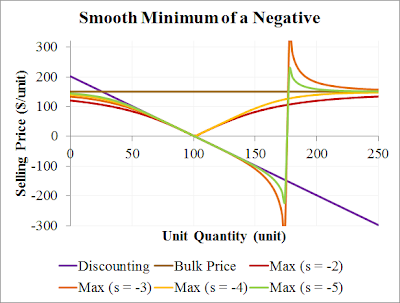The above formula is basically a p-norm (and is the Euclidean norm when \(s\) = 2). Here's a chart of it in action on \(d\) and \(u\) with \(s\) set to 2, 4, 6 and 8:
 |
| Example of a smooth maximum function for combining formulas. |
 |
| Example of the effect of a negative input on the smooth maximum. |
That's not so good. The even strengths stay above both inputs, but diverge further and further above the intended maximum. The odd strengths (only one shown) start to trend towards the negative input, because towards the right, it is the largest in absolute value.
Before we attempt to deal with this issue, let's look at another interesting behaviour. Let's consider negative strengths. This chart shows strengths of -2, -3, -4 and -5:
 |
| A negative strength produces a smooth minimum function! |
That's a convenient way to take the continuous minimum! And what happens when we feed in negative inputs? Well, it gets a little crazy:
 |
| A smooth minimum of a negative input does not look pretty. |
So then, how might we deal with negative inputs? One way would be to transform inputs from the full number line onto just the positive half. To do that we turn to exponentiation. So here's the updated continuous maximum/minimum function, generalised to any number of functions: $$m(x, s) = \ln_b\left(\left[ \sum_{i=1}^q (b^{f_i(x)})^s \right]^{1/s}\right),$$ where \(b\) is the base of exponentiation. So, let's test it. I initially tried \(w = e\), but ran into overflow issues, and instead have used the value 1.01. Here is the maximum and minimum of positive and negative inputs, with \(s\) being 2, 5, -2 and -5:
 |
| A smooth minimum and maximum function that works with negative inputs. |
One final thing. To use this in Lisp on individual values, evaluate this (with MathP):
(defun smooth-min-max (b s &rest vals)
"Smooth minimum (s < -1) or maximum"
#M log(reduce{#'+ vals :key fn(v) (b^v)^s}^(1/s) b))
And to construct a function that minimises or maximises other functions, try something like this:
(defun smooth-min-max-lambda (b s &rest funcs)
"Returns a function that calculates a smooth min/max of the
given base and strength. If b > 1, positive s does maximisation,
negative s minimisation. If 0 < b < 1, it is reversed."
(assert (or (< 0 b 1) (> b 1)))
(assert (not (zerop s)))
#M fn(&rest args) log(reduce(#'+ funcs :key fn(f) (b^apply(f args))^s)^(1/s) b))
Enjoy!
This comment has been removed by the author.
ReplyDeleteYour Function is flawed consider b^0 = 1 therefore say you have f1(x) = 0, f2(x) = 0 and f3(x) = 0 your function reduced to (1^s+1^s+1^s)^(1/s) = 3^(1/s) != 1 therefor log_b(3^(1/s)) != 0, note this error is only significant near 0, i.e. as any single value -> inf the error -> 0,
ReplyDeleteif you set s=1, then it can be corrected by subtracting q-1 from the sum
In case x values where 0 the gradient will be divided by 0. how this could be solved without adding constant value.
ReplyDelete188bet - THTOP Bet
ReplyDelete188bet: 188bet.me; 온카지노 188bet.me; 188bet 188bet.me. 188bet.me; 188bet.me. 188bet.me; 188bet.me. 188bet.me.